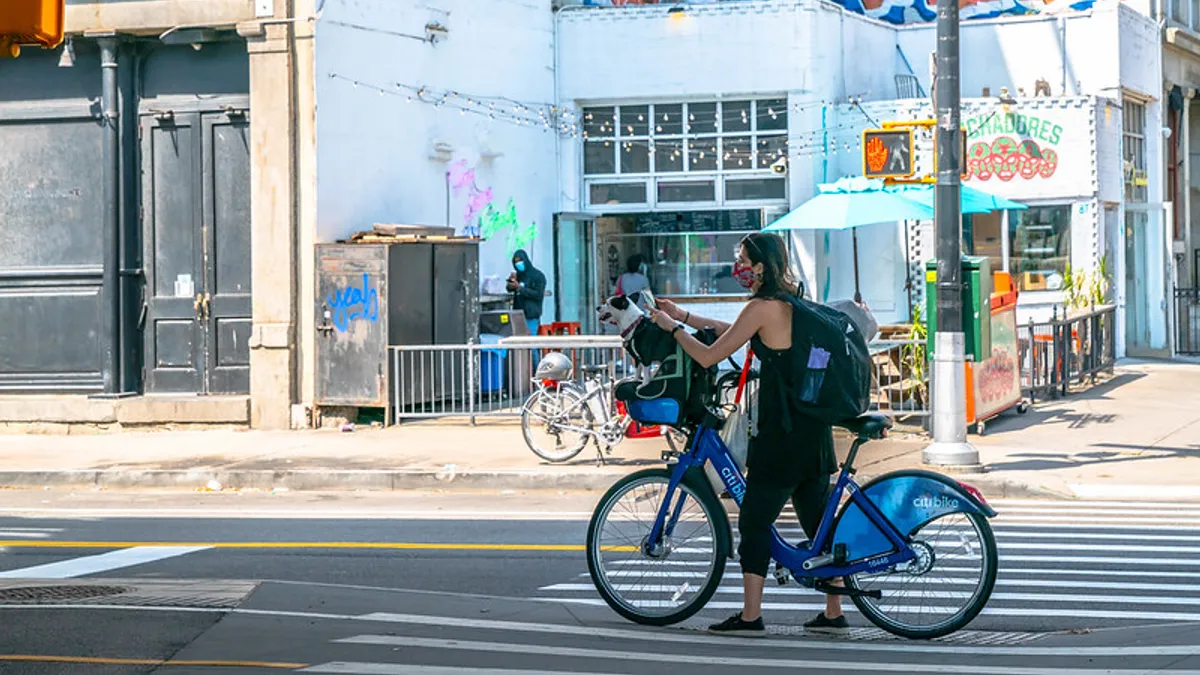Dive Brief:
- The team behind nonprofit Open Plans has unveiled CityRise, a campaign to engage New York City's public in demanding safe, accessible and car-free streets.
- CityRise is seeking endorsements from business owners, nonprofits, community groups, schools, political leaders and the general public to advocate for actionable plans that support bike networks, open streets and dedicated HOV and bus lanes, among other policies. Since its Sept. 24 launch, CityRise has signed-on 66 volunteers to help with its neighborhood network planning efforts.
- As New York recovers from the COVID-19 pandemic, the work of CityRise will be crucial in ensuring residents don't turn to cars as a primary transportation option, said Mark Gorton, founder of Open Plans and the "moving force" behind CityRise. Supporting alternative forms of transportation is "the key to making New York economically vibrant in the future," he said.
Dive Insight:
Gorton has long been an advocate for livable streets in New York, and has channeled this passion into a number of projects including the popular site Streetsblog. He said he has noticed a huge growth in New York's cycling community since the onset of the pandemic, but this growth is threatened by a possible resurgence of car use as more offices reopen and commuters try to stay socially distanced.
The threat is also amplified by Mayor Bill de Blasio's inaction, Gorton said. He suggested that while de Blasio has publicly advocated for car-free streets, his intentions are not so direct behind closed doors. Gorton claims the mayor has refused to listen to the advice of experts in quickly taking action on livable streets, resulting in a "hostile" bureaucratic environment.
The city also cut funding for bike lane infrastructure and expanded bus lanes in its FY21 budget.
"It’s so, so sad that we don’t have anybody who’s thinking collectively about this," Gorton said. "It’s pathetic that we have to be protesting for basic bike infrastructure in the middle of a crisis where it’s super obvious that the bike is the number one best transportation response to the pandemic."
De Blasio's administration hasn't ignored demands for more pedestrian and cycling space, however. The city did test an open streets concept that it recently made permanent for the city's restaurants. Gorton said these efforts are "very positive," but must be expanded to support other businesses and areas of the city still prioritizing cars over public use of space.
New York's long-standing prioritization of cars has "been a pathology" that the public is finally starting to see through with the introduction of this open streets concept, Gorton said. "It’s really been ridiculously stupid for years, and now that it’s taken a crisis to change these policies, all of a sudden people are like, 'Wait, this is so much better'."
While the potential "elimination" of cars on some roads could create a budgetary deficit — the city brought in nearly $1 billion in revenues in 2016 via parking fines — there are revenue-positive ways to support a societal shift away from cars, Gorton said. He suggested the city eliminate its access to free parking to make up for revenues lost to open streets programs.
Beyond direct city revenues, adding open streets to more business districts could keep thousands of retailers in business, he said. "They're tax-paying businesses, they have employees, and letting those businesses fail is an economic crisis."
Gorton also acknowledged national reports of New Yorkers fleeing the city and said more pedestrian-friendly streets will be crucial in keeping the city an attractive place to live. "If we mismanage the city and allow it to become a traffic-choke hell, more and more people are going to leave," he said.
"The mayor is just not doing anything. It's one thing to say, let's have more people take the bus, let's have biking, but it takes many, many months — even moving under quick, temporary emergency measures — to actually repurpose streets to make things happen," Gorton said.
Moving quickly to repurpose streets will be key, especially with the city's introduction of e-bikes and e-scooters on the horizon in March. Gorton said CityRise could advance low-cost, quick-action solutions like "bike boulevards" that use dividers or planters to create a bike network. These solutions could also support the projected influx of micromobility vehicles in 2021.
Other solutions detailed by Gorton include the expansion of car-share programs and the repurposing of parking garages as primary parking space to free up the curb.
"There is a path to recovery that works for New York, that yields a city that is economically vibrant, that is livable and that is healthy," Gorton said. "This is not something where you have to have these very hard trade-offs, you just have to do it right. And we’re doing it wrong now."
The New York City Department of Transportation has not yet responded to a request for comment on the coalition.












